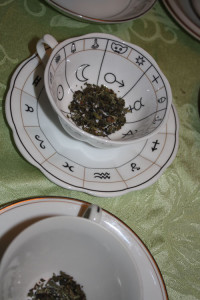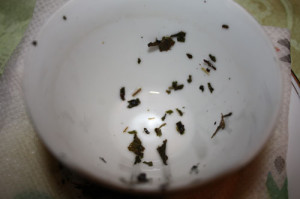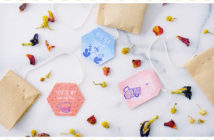In a gypsy’s arsenal of fortune-telling supplies, teacups frequently make an appearance among pendulums, palms, crystals, and tarot cards.
Tasseography, or predicting the future by interpreting patterns in tea leaves, originated in the 17th century when the Dutch introduced tea to Europe. Clairvoyants and psychics would look at the shapes left in a cup after the tea was consumed and “read” the leaves to answer specific questions. After that, nomadic gypsies embraced the practice and carried the art throughout the world.
Luckily, you don’t need to be a psychic these days to interpret the cup. With basic knowledge of symbols and their meanings, anyone can be a tasseographer. So grab some loose-leaf, some cups, and some friends, and set the kettle on. Here’s a quick guide to reading tea leaves.
Get Prepared
Tasseography doesn’t require specialized materials. You can use any teacup and saucer—although ones that are blank on the inside or specific to the reading are easier to interpret—and any loose-leaf tea as long as it isn’t dusty or has tiny leaves. You may even want to let your seeker pick out their cup and tea to make the reading more personal. To make it easier on yourself, try to stay away from cups with straight vertical sides, cups that aren’t circles, dark-colored cups, and cups with scalloped edges. And make sure every cup you use has a handle.
To start, put about a teaspoon of loose-leaf tea into the cup. Chinese tea is the most popular, but any type that has a broad leaf will work. I usually use mint tea in my readings as it is large and easy to read, plus the smell and taste are almost universally enjoyed. Pour in hot water from a kettle and let the tea steep. Do not strain it—you need all the leaves in the cup to do a proper reading.
Handling the Brew
Once the tea is steeped and ready to go, have the seeker meditate on the cup while they drink. If there’s a specific question they want answered, the seeker should concentrate on that. Otherwise, they should think about their life in general so far. Have them continue drinking until about a teaspoon of liquid remains in the cup.
At this point, the seeker must grasp the handle of the cup with their left hand and swirl the tea around three times, being sure to swivel the cup onto its sides as well. Men should rotate the cup clockwise; women, counterclockwise. Then, the seeker should flip the cup upside down and place it on the dish. It helps to have a cloth or napkin on the saucer to soak up the extra liquid.
Wait a moment for the tea to completely drain out of the cup, then have the seeker pick the cup up by the handle and place it right-side up on the dish. You can now begin your reading.
Telling Fortunes
Tasseography is a short-term prediction—tea leaves only predict about a year into the future. The rim of the cup represents the present day, and the base correlates to a year in advance. As you read the leaves further down into the cup, you’re getting farther into the future. The handle of the cup represents the seeker. The closer the leaves are to the handle, the more direct an influence that part of the reading will have.
Keep this in mind as you meditate for a few moments on the placement of the leaves in the cup. Pick it up and twist it around so you can see the leaves from all angles. After a few moments, you will be able to see shapes and patterns in the tea.
The type of images you’ll see in the cup are virtually limitless, but to get you started, here are some of the more common ones and their meanings.
*Heart: Symbolizes affection and love.
*Line: Symbolizes a journey. A straight, unbroken line references good forward progress; a broken line indicates challenges during the journey.
*Anchor: An anchor is generally a good sign, symbolizing prosperity.
*Square: Indicates being boxed in. It is a sign of limitation and possibly oppression, imprisonment, or illness. Trouble may be on the way.
*Bird: A flying bird indicates the upcoming arrival of good news. A resting bird symbolizes an end to a successful journey.
*Boat: Depending on the placement in the cup, a boat suggests an upcoming journey, a removal of something from the seeker’s life, or a refuge in time of need.
*Dragon: Dragons precaution seekers to let their heads and good sanity lead decision-making. An upcoming, possibly terrifying, event will require it in order for the seeker to come out successful.
*Dog: Canines in the cup refer to friendships. Pay close attention to the dog’s stance in order to interpret the meaning. For example, a begging dog indicates someone will come asking for a favor soon. A sad dog represents an injustice suffered by a friend.
*Human: Figures of people also should be read based on the image’s attitude. A positive stance is a good sign, and negativity signifies evil.
*Numbers: Look at the symbols around any numbers to determine the true meaning. Numerals could signify days of the week, time, or amounts.
*Turtle: Symbolizes a slow but profitable journey. The seeker will work hard without seeing immediate results, but extreme success will follow.
Remember to interpret any symbols based on their location in the cup and to each other. For example, in one of my recent readings, the leaves formed a line leading straight down into a heart, next to a ring. I interpreted that to mean the seeker would go on a direct journey and fall in love, with the possibility of marriage. But off to the side of the heart was a devil, which stands for falsehood and temptation. The seeker needs to avoid those pitfalls in order to see the love on the way.
For more in-depth information on reading tea leaves, visit Serena Powers.








